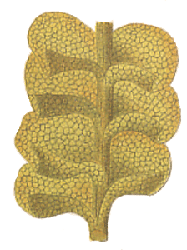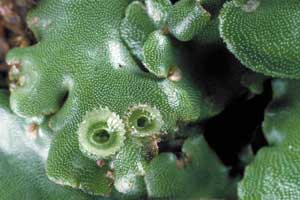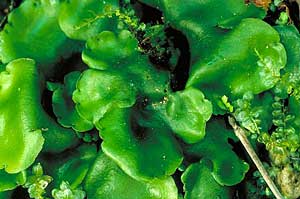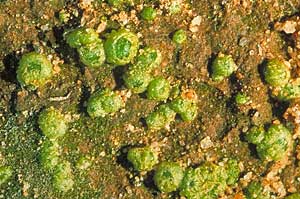
Classification and identification
Liverworts (phylum Marchantiophyta)
The starting point is the liverwort classification scheme set out in the paper given in the next Reference button. That classification is based primarily on morphology (macroscopic and microscopic) and cellular structure and, for the sake of brevity, will be referred to as the 2000 classification on this web page. It provides a good framework on which to build a short account of the principles of liverwort classification and against which to contrast some findings from later studies![]() .
.
The 2000 classification divides the liverworts into two classes: Marchantiopsida and Jungermanniopsida. All the complex thallose liverworts are in the former and all the leafy liverworts in the latter. Simple thallose liverworts are found in both classes, though mostly in the latter. The precise definitions of the two classes are based on a number of microscopic morphological features. For example, in the Marchantiopsida the wall of the spore capsule is single layered whereas in the Jungermanniopsida the wall of the spore capsule has two or more layers (except for the genus Haplomitrium). Spores develop from what are called spore mother cells. In the Marchantiopsida the spore mother cells are unlobed whereas in the Jungermanniopsida they are lobed. There are also differences in the initial stages of the development of the sperm-producing antheridia in the two classes. The class Jungermanniopsida is much, much larger than Marchantiopsida. The leafy liverwort species far outnumber the thallose species.
Further differentiation into lower taxonomic ranks is based on a wide variety of gametophytic and sporophytic features. The structure of the sporophyte foot, leaf form, internal thallus differentiation, manner of opening of the spore capsule, gemma structure, protonemal development and nature of elaters are just some examples. All of those are also relevant to one or both of moss and hornwort classification. Since this page doesn't aim to give a full description of liverwort classification there'll be no further discussion of any such features except for one, oil bodies, that are peculiar to the liverworts.
Oil bodies, containing a variety of terpenoid oils, are found in about 90% of liverwort species and are distinct cell organelles. Other plants (not just other bryophytes) may have oil droplets but the oil bodies of liverworts are bounded by true membranes. The oil bodies vary greatly in size, shape, colour, chemical composition and distribution within cells. Oil bodies typically disappear in dried, herbarium specimens and are best studied in fresh material. There have been various hypotheses about the functions of oil bodies (e.g. UV protection, cold resistance, herbivore deterrence) but there is insufficient evidence for definite conclusions. ![]() .
.
The rest of this page will be devoted to a discussion of some examples from the two classes of the 2000 classification and some comments based on more recent molecular studies.
Marchantiopsida
The 2000 classification divides the class Marchantiopsida into two sub-classes: Marchantiidae (complex thallose) and Sphaerocarpidae (simple thallose).
Sphaerocarpales, the only order in the sub-class Sphaerocarpidae, contains the two families Sphaerocarpaceae and Riellaceae. The first is composed of two genera, Sphaerocarpos ![]() (with about 10 species) and Geothallus with one species. Riella, with about 20 species, is the only genus in the family Riellaceae.
(with about 10 species) and Geothallus with one species. Riella, with about 20 species, is the only genus in the family Riellaceae.
Within the sub-class Marchantiidae the bulk of the complex thallose liverworts are placed in the order Marchantiales. The order derives its name from the genus Marchantia (family Marchantiaceae) and the thick, somewhat leathery thalli of the species in this genus are well-known to many people. Superficially the thick, leathery thallus of Monoclea forsteri is reminiscent of a Marchantia thallus, and the classification of Monoclea has been much debated. The genus has features reminiscent of several liverwort orders but in the 2000 classification the genus was considered distinct enough to be placed in its own order, Monocleales. On the other hand, the genus Monocarpus (with just the one species, Monocarpus sphaerocarpus) was placed in the Marchantiales, though at first glance it seems very un-Marchantia-like. An individual, unfertilized Monocarpus gametophyte is a thin, flat thallus no more than a few millimetres in diameter. Once fertilized the thallus margins grow up to form a protective sheath, or involucre, around the developing spore capsule.
The upward, post-fertilization growth of the thallus gives Monocarpus an appearance resembling that of Sphaerocarpos. There are some other points of resemblance between Monocarpus and Sphaerocarpos. For example, both lack ELATERS and oil bodies and the spore capsules break open in similar ways. However, there are also differences such as different archegonial arrangements and after fertilization the Monocarpus thallus develops air pores on the upper parts of the involucre. Sphaerocarpos lacks air pores but they are a very obvious feature in Marchantia thalli. The white dots on the thalli in this photo ![]() are air pores.
are air pores.
Other examples of liverworts in the order Marchantiales are Asterella ![]() , Plagiochasma
, Plagiochasma ![]() and Reboulia
and Reboulia ![]() (all in the family Aytoniaceae), Lunularia
(all in the family Aytoniaceae), Lunularia ![]() (Lunulariaceae) and Targionia
(Lunulariaceae) and Targionia ![]() (Targioniaceae). A great many of the Marchantiales are noteworthy for the elaborate structures that develop to hold the spore capsules and some are shown in those linked photos.
(Targioniaceae). A great many of the Marchantiales are noteworthy for the elaborate structures that develop to hold the spore capsules and some are shown in those linked photos.
There is one more order in the Marchantiidae, Ricciales, with two families: Oxymitraceae and Ricciaceae. The former contains just one genus, Oxymitra ![]() , with four species. The latter has two genera – the terrestrial Riccia
, with four species. The latter has two genera – the terrestrial Riccia ![]() , with many species, and the aquatic Ricciocarpos, with just the one species Ricciocarpos natans
, with many species, and the aquatic Ricciocarpos, with just the one species Ricciocarpos natans ![]() . Oxymitra spore capsules are sessile on the thallus and disintegrate once the spores are mature. Spore capsules in the Ricciales are embedded in the thallus and disintegrate at maturity, leaving the spores within an internal chamber that opens by disintegration of the overlying thallus cells.
. Oxymitra spore capsules are sessile on the thallus and disintegrate once the spores are mature. Spore capsules in the Ricciales are embedded in the thallus and disintegrate at maturity, leaving the spores within an internal chamber that opens by disintegration of the overlying thallus cells.
Jungermanniopsida
In the 2000 classification the class Jungermanniopsida is divided into two sub-classes: Metzgeriidae (simple thallose liverworts) and Jungermanniidae (leafy liverworts). To discuss the division of these sub-classes into orders would mean going into too much technical detail. In lieu of descriptions of the orders we'll finish this section with illustrations of a few liverworts in the class Jungermanniopsida.
Examples of the subclass Metzgeriidae are Fossombronia and Petalophyllum (both Fossombroniaceae, Fossombroniales), Aneura ![]() and Riccardia
and Riccardia ![]() (both Aneuraceae, Metzgeriales), Symphyogyna (Pallaviciniaceae, Metzgeriales)
(both Aneuraceae, Metzgeriales), Symphyogyna (Pallaviciniaceae, Metzgeriales) ![]() and Hymenophyton (Hymenophytaceae, Metgeriales)
and Hymenophyton (Hymenophytaceae, Metgeriales) ![]() .
.
Here are some examples of the subclass Jungermanniidae. The following are in the order Jungermanniales: Chiloscyphus (Geocalycaceae) ![]() , Lepidozia
, Lepidozia ![]() and Zoopsis
and Zoopsis ![]() (both Lepidoziaceae), Enigmella
(both Lepidoziaceae), Enigmella ![]() and Lethocolea
and Lethocolea ![]() (both Acrobolbaceae). The following are in the class Lepicoleales: Chaetophyllopsis (Chaetophyllopsidaceae)
(both Acrobolbaceae). The following are in the class Lepicoleales: Chaetophyllopsis (Chaetophyllopsidaceae) ![]() , Schistochila (Schistochilaceae)
, Schistochila (Schistochilaceae) ![]() , Trichocolea (Trichocoleaceae)
, Trichocolea (Trichocoleaceae) ![]() . In the order Porellales are Frullania (Jubulaceae)
. In the order Porellales are Frullania (Jubulaceae) ![]() , Acrolejeunea
, Acrolejeunea ![]() , Cololejeunea
, Cololejeunea ![]() and Lopholejeunea
and Lopholejeunea ![]() (the last three all Lejeunaceae). The final example is Radula (Radulaceae, Radulales)
(the last three all Lejeunaceae). The final example is Radula (Radulaceae, Radulales) ![]() .
.
Marchantiophyta – classes, orders and molecules
The few years since the publication of the 2000 classification has seen considerable investigation into liverwort classification, particularly by molecular methods. Before going further, here is a summary of the high-level classification of the liverworts according to the 2000 classification. You can see that there have been considerable differences in estimates of numbers of species for some orders. This reflects both differences in opinion regarding species boundaries and also the fact that many groups of liverworts have not been thoroughly investigated. Following this summary there will be some comments about the implications of more recent research.
class: Marchantiopsidasub-class: Sphaerocarpidae order: Sphaerocarpales (2 families, 3 genera, about 30 species) sub-class: Marchantiidae order: Marchantiales (12 families, 28 genera, about 200 species) order: Monocleales (1 family, 1 genus, 4 species) order: Ricciales (2 families, 3 genera, 150-300 species) class: Jungermanniopsidasub-class: Metzgeriidae order: Haplomitriales (1 family, 1 genus, about 10 species) order: Blasiales (1 family 2 genera, 5 species) order: Treubiales (2 families, 3 genera, about 10 species) order: Fossombroniales (4 families, 9 genera, 80 species) order: Metzgeriales (7 families, 22 genera, about 300 species) sub-class: Jungermannidae order: Lepicoleales (11 families, 21 genera, 110 species) order: Jungermanniales (24 families, 183 genera, several thousand species) order: Porellales (5 families, 97 genera, several thousand species) order: Radulales (1 family, 1 genus, 150-300 species) order: Pleuroziales (1 family, 1 genus, no more than about 25 species) |
The rest of this page is based on information presented in the paper noted in the following Reference button![]() .
.
The authors of that paper have proposed a number of significant changes to the 2000 classification at the level of order and above. This is a contrast to recently proposed changes to the corresponding 2000 classification for mosses, given on the MOSS CLASSIFICATION page. The 2000 classification of mosses had already incorporated molecular evidence whereas the corresponding liverwort classification had to be based primarily on non-molecular data. That simply reflected the different levels of molecular information then available for those two bryophyte groups.
Here are some of the findings presented in the paper given in the previous Reference button.
The families Haplomitriaceae and Treubiaceae (in the Haplomitriales and Treubiales in the above table) would form a distinct class, Haplomitriopsida. Previously the two families hadn't been thought to be very closely related but the molecular evidence strongly supports that idea.
The Blasiales would be grouped with the complex, rather than the simple, thallose liverworts.
From the above table you can see that the liverworts in the class Pleuroziales are leafy liverworts. However the molecular evidence strongly supports grouping those liverworts with the simple thallose liverworts.
The molecular evidence would place the Ricciales within the Marchantiales.
The authors noted that their work was by no means the final word on liverwort classification since there are still many critical liverwort species that have not been analysed. There's more about liverwort classification in the Phylogeny section of the Liverwort Tree of Life website. That website should remain a good source of information about the subject since it is maintained by active researchers and so will be updated as additional research results become available.
![An Australian Government Initiative [logo]](/images/austgovt_brown_90px.gif)




